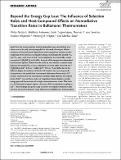Beyond the energy gap law : the influence of selection rules and host compound effects on nonradiative transition rates in boltzmann thermometers
Abstract
Apart from the energy gap law, control parameters over nonradiative transitions are so far only scarcely regarded. In this work, the impact of both covalence of the lanthanoid–ligand bond and varying bond distance on the magnitude of the intrinsic nonradiative decay rate between the excited 6P5/2 and 6P7/2 spin–orbit levels of Gd3+ is investigated in the chemically related compounds Y2[B2(SO4)6] and LaBO3. Analysis of the temperature-dependent luminescence spectra reveals that the intrinsic nonradiative transition rates between the excited 6PJ ( J = 5/2, 7/2) levels are of the order of only 10 ms−1 (Y2[B2(SO4)6]:Gd3+: 8.9 ms−1; LaBO3:Gd3+: 10.5 ms−1) and differ due to the different degree of covalence of the Gd—O bonds in the two compounds. Comparison to the established luminescent Boltzmann thermometer Er3+ reveals, however, that the nonradiative transition rates between the excited levels of Gd3+ are over three orders of magnitude slower despite a similar energy gap and the presence of a single resonant phonon mode. This hints to a fundamental magnetic dipolar character of the nonradiative coupling in Gd3+. These findings can pave a way to control nonradiative transition rates and how to tune the dynamic range of luminescent Boltzmann thermometers.
Citation
Netzsch , P , Hämmer , M , Turgunbajew , E , van Swieten , T P , Meijerink , A , Höppe , H A & Suta , M 2022 , ' Beyond the energy gap law : the influence of selection rules and host compound effects on nonradiative transition rates in boltzmann thermometers ' , Advanced Optical Materials , vol. 10 , no. 11 , 2200059 . https://doi.org/10.1002/adom.202200059
Publication
Advanced Optical Materials
Status
Peer reviewed
ISSN
2195-1071Type
Journal article
Description
P.N. and M.H. contributed equally to this work. H.A.H., P.N., M.H., and E.T. thank the Deutsche Forschungsgemeinschaft (DFG) for generous support (Project HO 4503/5-1). Open access funding enabled and organized by Projekt DEAL.Collections
Items in the St Andrews Research Repository are protected by copyright, with all rights reserved, unless otherwise indicated.

